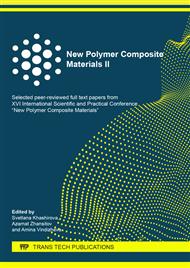[1]
D.J. Liaw, K.L. Wang, Y.C. Huang, K.R. Lee, J.Y. Lai, C.S. Ha, Advanced polyimide materials: syntheses, physical properties and applications, Prog. Polym. Sci. 37 (2012) 907-974.
DOI: 10.1016/j.progpolymsci.2012.02.005
Google Scholar
[2]
Q.H. Zhang, M. Dai, M.X. Ding, D.J. Chen, L.X. Gao, Mechanical properties of BPDA-ODA polyimide fibers, Eur. Polym. J. 40 (2004) 2487-2493.
DOI: 10.1016/j.eurpolymj.2004.06.020
Google Scholar
[3]
G.M. Mikhailov, L.N. Korzhavin, M.F. Lebedeva, Yu.G. Baklagina, The basic principles of the design of macromolecules of fiber-forming aromatic homopolyimides to obtain heat-resistant fibers with a given set of deformation-strength properties. / Journal of Applied Chemistry. (1998) 2040-2050. (in Russian).
Google Scholar
[4]
S. Mehdipour-Ataei, N. Bahri-Laleh, A. Amirshaghaghi, Comparison of one-step and two-step methods of polyimidization and substitution effect in the synthesis of new poly(ester-imide)s with bulky pendent group, Polym. Degrad. Stabil. 91 (2006) 2622-2631.
DOI: 10.1016/j.polymdegradstab.2006.05.004
Google Scholar
[5]
J. Dong, C. Yin, W. Luo, Q. Zhang, Synthesis of organ-soluble copolyimides by one-step polymerization and fabrication of high performance fibers, J. Mat. Sci. 48 (2013) 7594-7602.
DOI: 10.1007/s10853-013-7576-2
Google Scholar
[6]
N. Peng, N. Widjojo, P.Sukitpaneenit, M. Teoh, G. Lipscomb, T.-S. Chung, J.-Yi. Lai, Evolution of polymeric hollow fibers as sustainable technologies: Past, present, and future, Progress in Polymer Science. 37 (2012) 1401-1424.
DOI: 10.1016/j.progpolymsci.2012.01.001
Google Scholar
[7]
Y. Li, B.Cao, P.Li, Fabrication of PMDA-ODA hollow fibers with regular cross-section morphologies and study on the formation mechanism, J. Mem. Sci. 544 (2017) 1-11.
DOI: 10.1016/j.memsci.2017.08.070
Google Scholar
[8]
W. Albrecht, T.M. Weigel, K. Schossig-Tiedemann, K.V. Kneifel, D.P. Peinemann Formation of hollow fiber membranes from poly(ether imide) at wet phase inversion using binary mixtures of solvents for the preparation of the dope, J. Membr. Sci. 192 (2001) 217-230.
DOI: 10.1016/s0376-7388(01)00504-x
Google Scholar
[9]
V.E. Yudin, V. M.Svetlichnyi, G.N. Gubanova, A.L. Didenko, T.E. Suchanova, V.V. Kudryavtsev, Semicrystalline polyimide matrices for composites: crystallization and properties, J. Appl. Polym. Sci. 83 (2002) 2873-2882.
DOI: 10.1002/app.10277
Google Scholar
[10]
V.E. Smirnova, I.V. Gofman, V.E. Yudin, I.P. Dobrovolskaya, A.N. Shumakov, A.L. Didenko, V.M. Svetlichnyi, E. Wachtel, R. Shechter, H. Harel, G. Marom, Orientated crystallization in drawn thermoplastic polyimide modified by carbon nanofibers, Polym. Eng.Sci. 49 (2009) 217-222.
DOI: 10.1002/pen.21241
Google Scholar
[11]
G.V. Vaganov, A.L. Didenko, E.M. Ivan'kova, E.N. Popova, V.Yu. Elokhovskii, A.V. Volkov, V.E. Yudin, Preparation and properties of a thermoplastic partially crystalline polyimide in the oriented state, Russ.J. Appl. Chem. 93 (2020) 72-79.
DOI: 10.1134/s1070427220010085
Google Scholar
[12]
M.M. Koton, O.V. Kallistov, V.V. Kudryavtsev, V.P. Sklizkova, I.G. Silinskaya, About the effect of the nature of the amide solvent on the molecular characteristics of poly (4,4-oxydiphenylene) pyromellitamido acids, Polymer Science U.S.S.R., 21 (1979) 532-535.
DOI: 10.1016/0032-3950(79)90280-6
Google Scholar
[13]
I.G. Silinskaya, V.M. Svetlichnyi, N.A. Kalinina, A.L. Didenko, A.P. Filippov, V.V. Kudryavtsev, Molecular characteristics and solution behavior of prepolymers of several polyimides: Effect of synthesis conditions, Polym. Sci. A. 48 (2006) 787-792.
DOI: 10.1134/s0965545x06080037
Google Scholar
[14]
A.B. Shipovskaya, Rheological properties of solutions and melts of fiber-forming polymers, Saratov. State University, Saratov, 2015. (in Russian).
Google Scholar
[15]
V.E. Yudin, V.M. Svetlichnyi, G.N. Gubanova, A.L. Didenko, E.N. Popova, T.E. Suchanova, A.I. Grigoriev, T.A. Kostereva, I. Arbel, G. Maron, Influence of crystallinity of R-BAPB-type polyimide matrix on thermal and mechanical properties of carbon-fiber-reinforced composites, Polyimides and other high temperature polymers: Synthesis, Characterization and Applications, 3 (2005) 299-316.
DOI: 10.1201/b12194-19
Google Scholar


